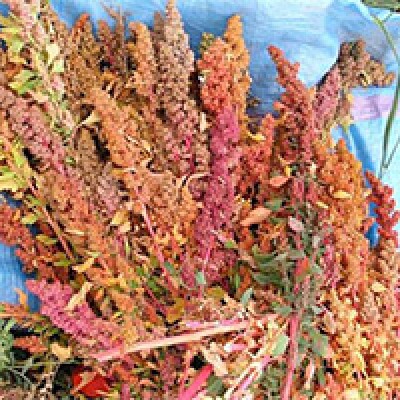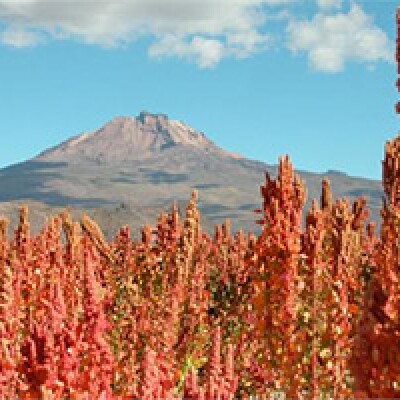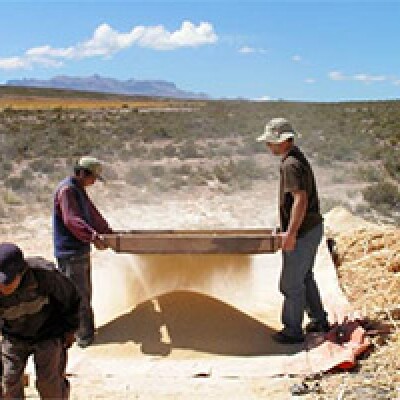Quinoa






Quinoa (Chenopodium quinoa)
Quinoa (the name is derived from the Spanish spelling of the Quechua name kinwa or occasionally "Qin-wah") originated in the Andean region of Argentina, Bolivia, Chile, Colombia, Ecuador, and Peru, where it was successfully domesticated 3,000 to 5,000 years ago for human consumption, though archeological evidence shows a non-domesticated association with pastoral herding some 5,200 to 7,000 years ago. Quinoa seeds contain essential amino acids like lysine and good quantities of calcium, phosphorus, and iron. After harvest, the seeds need to be processed to remove the coating containing the bitter-tasting saponins. Quinoa seeds are in general cooked the same way as rice and can be used in a wide range of dishes. Quinoa leaves are also eaten as a leafy vegetable, much like its relatives spinach, chard, and amaranth, but the commercial availability of quinoa greens is limited. Other forms of quinoa were domesticated independently from the weedy progenitor pitseed goosefoot (C. berlandieri) in ancient North America, including Mesoamerican 'huauzontle' as an inflorescence vegetable and at least one now-extinct seed crop known from extensive archeological evidence in the Mississippi and Ohio Valleys.
Chenopodium quinoa - Phytozome v12.1 - More On Quinoa
"While no single food can supply all the essential life sustaining nutrients, quinoa comes as close as any other in the plant or animal kingdom" - NASA technical paper 3422
Journal Publications
The complete Quinoa Genome Sequence assembly can be found in Phytozome. Click here to listen to Dr. Jellen talk about the genome.
Jellen EN, Jarvis DE, Hunt SP, Mangelson HH, Maughan PJ (2019) New seed collections of North American pitseed goosefoot (Chenopodium berlandieri) and efforts to identify its diploid ancestors through whole-genome sequencing. International Journal of Agricultural Sciences and Natural Resources. Cien. Inv. Agr. 46(2):12-22
Maughan PJ, Chaney L, Lightfoot DJ, Cox BJ, Tester M, Jellen EN, Jarvis DE (2018) Mitochondrial and chloroplast genomes provide insights into the evolutionary origins of quinoa (Chenopodium quinoa Willd.) Scientific Reports 9(1):185
Schmöckel SM, Lightfoot DJ, Razali R, Tester M, Jarvis DE (2017) Identification of putative transmembrane proteins involved in salinity tolerance in Chenopodium quinoa by integrating physiological data, RNAseq, and SNP analyses. Frontiers in Plant Science 8:1023
Jarvis DE, Ho YS, Lightfoot DJ, Schmöckel SM, Li B, Borm T, Ohyanagi H, Mineta K, Michell CT, Saber N, Kharbatia NM, Rupper RR, Sharp AR, Dally N, Boughton BA, Woo YH, Gao G, Schijlen E, Guo X, Momin AA, Negrão S, Al-Babili S, Gehring C, Roessner U, Jung C, Murphy K, Arold ST, Gojobori T, van der Linden G, van Loo EN, Jellen EN, Maughan PJ, Tester M (2017) The genome of Chenopodium quinoa. Nature 1-6 doi:10.1038/nature21370
Mandak B, Krak K, Vit P, Pavlikova Z, Lomonosova M, Habibi F, Lei W, Jellen EN, Douda J (2016) How genome size variation is linked with evolution within Chenopodium sensu lato. Perspectives in Plant Ecology, Evolution and Systematics23:18-32
Benlhabib O, Boujartani N, Maughan PJ, Jacobsen SE, Jellen EN (2016) Elevated genetic diversity in an F2:6 population of quinoa (Chenopodium quinoa) developed through an inter-ecotype cross. Front. Plant Sci. 7:1222
Walsh BM, Adhikary D, Maughan PJ, Emshwiller E, Jellen EN (2015) Chenopodium (Amaranthaceae) polyploidy inferences from Salt Over Sensitive 1 (SOS1) data.American Journal of Botany 102(4):1-11
Cepeda-Cornejo V, Brown DC, Palomino G, de la Cruz E, Fogarty M, Maughan PJ, Jellen EN (2015) Genetic variation for the Granule Bound Starch Synthase I genes (GBSSI) in waxy and non-waxy accessions of Chenopodium berlandieri ssp. nuttaliae from central Mexico. Plant Genetic Resources 8(1): 1-11
Brown DC, Cepeda-Cornejo V, Maughan PJ, Jellen EN (2014) Characterization of the Granule - Bound Starch Synthase I Gene in Chenopodium. Plant Genome 2014. doi: 10.3835/plantgenome2014.09.0051
Raney JA, Reynolds DJ, Elzinga DB, Page J, Udall JA , Jellen EN, Bonfacio A, Fairbanks DJ, Maughan PJ. Transcriptome Analysis of Drought Induced Stress in Chenopodium quinoa. Amer. J. Plant Sci. 2014 5(3): 338.357. doi: 10.4236/ajps.2014.53047
Maughan PJ, Smith SM, Rojas-Beltrán JA, Elzinga D, Raney JA, Jellen EN, Bonifacio A, Udall JA, Fairbanks D. Single nucleotide polymorphisms identification, characterization and linkage mapping in Chenopodium quinoa. The Plant Genome. 2012 Sep;5(3):1-7
Morales AJ, Bajgain P, Garver Z, Maughan PJ, Udall JA. Physiological responses of Chenopodium quinoa to salt stress. Int. J. Plant Physiol. Biochem. 2011 Nov;3:219-232.
Kolano B, Gardunia BW, Michalska M, Bonifacio A, Fairbanks D, Maughan PJ, Coleman CE, Stevens MR, Jellen EN, Maluszynska J. Chromosomal localization of two novel repetitive sequences isolated from the Chenopodium quinoa Willd. Genome. Genome. 2011 Jul;54:710-717.
Maughan PJ, Yourstone SM, Byers RL, Smith SM, Udall JA. SNP genotyping in mapping populations via genomic reduction and next-generation sequencing: Proof-of-concept. Plant Genome. 2010 Dec;3(3):168-188.
Maughan PJ, Turner TB, Coleman CE, Elzinga DB, Jellen EN, Morales JA, Udall JA, Fairbanks D, Bonifacio A. Characterization of salt overly sensitive (SOS1) gene homoeologs in quinoa (Chenopodium quinoa Willd). Genome. 2009 Jul;52:647-657.
Fuentes FF, Martinez EA, Hinrichsen PV, Jellen EN, Maughan PJ. Assessment of Genetic Diversity Patterns in Chilean Quinoa (Chenopodium quinoa Willd.) Using Multiplex Fluorescent Microsatellite Markers. Conservation Genetics. 2009 Apr;10:369-377.
Jarvis DE, Kopp OR, Jellen EN, Mallory MA, Pattee J, Bonifacio A, Coleman CE, Stevens MR, Fairbanks DJ, Maughan PJ. Simple sequence repeat marker development and genetic mapping in quinoa (Chenopodium quinoa Willd.). Journal of Genetics. 2008 Apr;87:39-51.
Balzotti MR, Thornton JN, Maughan PJ, McClellan DA, Stevens MR, Jellen EN, Fairbanks DJ, Coleman CE. Expression and evolutionary relationships of the Chenopodium quinoa 11S seed storage protein gene. International Journal of Plant Sciences. 2008 Feb;169:281-291.
Christensen SA, Pratt DB, Pratt C, Nelson PT, Stevens MR, Jellen EN, Coleman CE, Fairbanks DJ, Bonifacio A, Maughan PJ. Assessment of genetic diversity in the USDA and CIP-FAO international nursery collections of quinoa (Chenopodium quinoa Willd.) using microsatellite markers. Plant Genetic Resources: Characterization and Utilization. 2007 Jun;5:82-95.
Maughan PJ, Kolano BA, Maluszynska J, Coles ND, Bonifacio A, Rojas J, Coleman CE, Stevens MR, Fairbanks DJ, Parkinson SE, et al. Molecular and cytological characterization of ribosomal DNAs in Chenopodium quinoa and Chenopodium berlandieri. Genome. 2006 Aug;49:825-839.
Stevens MR, Coleman CE, Parkinson SE, Maughan PJ, Zhang HB, Balzotti MR, Kooyman D, Arumuganathan K, Bonifacio A, Fairbanks DJ, et al. Construction of a quinoa (Chenopodium quinoa Willd.) BAC library and its use in identifying genes encoding seed storage proteins. Theoretical and Applied Genetics. 2006 May;112:1593-1600.
Mason SL, Stevens MR, Jellen EN, Bonifacio A, Fairbanks DJ, Coleman CE, Rasmussen AG, McCarty RR, Maughan PJ. Development and use of microsatellite markers for germplasm characterization in quinoa (Chenopodium quinoa Willd.). Crop Science. 2005 Aug;45:1618-1630.
Maughan PJ, Bonifacio A, Jellen EN, Stevens MR, Coleman CE, Ricks M, Mason SL, Jarvis DE, Gardunia BW, Fairbanks DJ. A genetic linkage map of quinoa (Chenopodium quinoa) based on AFLP, RAPD, and SSR markers. Theoretical and Applied Genetics. 2004;109:1188-1195.
Coles ND, Coleman CE, Christensen SA, Jellen EN, Stevens MR, Bonifacio A, Rojas-Beltran JA, Fairbanks DJ, Maughan PJ. Development and use of an expressed sequenced tag library in quinoa (Chenopodium quinoa Willd.) for the discovery of single nucleotide polymorphisms. Plant Science. 2004;168:439-447.
Book Chapters
Jellen EN, Maughan PJ, Fuentes F, Kolano BA (2014) Chapter 1.1. Botany, Phylogeny and Evolution (Botánica, Filogenia y Evolución). In: D. Bazile and T. Santivañez (eds), The 2013 state of the world's quinoa (Estado del arte de la quinua en el mundo en 2013). FAO (Santiago de Chile) y CIRAD, (Montpellier, Francia), pp. 26-39
Maughan PJ, Jellen EN, Raney JA (2014) 1.2. Quinoa Molecular and Genomic Tools (Herramientas Moleculares y Genómicas para la Quinua). In: D. Bazile and T. Santivañez (eds), The 2013 state of the world's quinoa (Estado del arte de la quinua en el mundo en 2013). FAO (Santiago de Chile) y CIRAD, (Montpellier, Francia), pp. 40-46
Jellen EN, Maughan PJ, Bertero D, Munir H. Prospects for Quinoa (Chenopodium quinoa Willd.) Improvement Through Biotechnology. In: SM Jain and SD Gupta, editors. Biotechnology of neglected and underutilized crops. 2013.
Jellen EN, Sederberg MC, Kolano BA, Bonifacio A, Maughan PJ. Chenopodium. In: C. Kole, editor. Wild Crop Relatives: Genomic and Breeding Resources. Berlin Heidelberg: Springer-Verlag; 2011. p. pp. 35-61
Fuentes FF, Maughan PJ, Jellen EN. Diversidad genetica y recursos geneticos para el mejoramiento de la quinoa (Chenopodium quinoa Willd). In: D. Bazile and J. Negrete, editors. Revista Geografica de Valparaiso. Valparaiso, Chile: Instituto de Geografia, Facultad de Recursos naturales/PUCV; 2009. vol. 42 p. 20-33
Maughan PJ, Bonifacio A, Coleman CE, Jellen EN, Stevens MR, Fairbanks DJ. Quinoa genomics. In: C Kole, editor. Genome Mapping and Molecular Breeding. Berlin: Springer-Verlag; 2007. vol. 3 p. 147-157
Public News Reports Concerning Our Quinoa Research
- BYU and LDS charities (May, 2017). Providing greater nutrition and food security in Morocco.
- Deseret News (Feb. 10, 2017). Major breakthrough by BYU 'orphaned crops lab' published in 'Nature'.
- Fox News13 (Feb. 10, 2017). Quinoa genome sequence published in Nature.
- BBC World service Newshour (Feb. 10, 2017). Could 'mapping' quinoa help feed the world's growing population?
- KSL.com (Feb. 10, 2017) - BYU professors, students work to fight world hunger with unique grain.
- The Salt Lake Tribune (Dec. 7, 2014; Jellen and Maughan): "Quinoa could feed the world, BYU researchers say - but will its spread hurt Andean countries?"
- The California Report (KQUED News): "How L.A.’s Wild Quinoa Can Help Fight Global Food Shortages" (Jellen), 2014:
- Harper's Magazine: Letters from Bolivia, “The Quinoa Quarrel, Who owns the world’s greatest superfood? (Maughan and Jellen), Harper's Magazine, May 2014, pg. 35-42.
- All things considered – National Public Radio (NPR): "Can Quinoa Farming Go Global Without Leaving Andeans Behind?" (Maughan) August 15, 2013